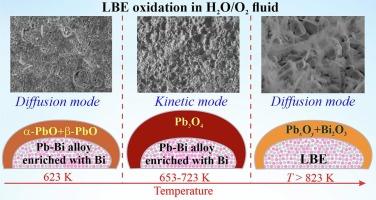水-氧流体中铅-铋共晶在高温高压下的氧化
IF 2.1
3区 工程技术
Q1 NUCLEAR SCIENCE & TECHNOLOGY
引用次数: 0
摘要
本文介绍了高压水氧流体氧化铅铋共晶(LBE)的研究结果。在水蒸气、氧气和H2O/O2混合环境中,以1 K/min的速率将LBE试样均匀加热至873 K,并将H2O/O2流体注入LBE试样的反应器中,在设定温度(623-873 K)下等温保温3 h。结果表明,628 K时,LBE在氧气和H2O/O2流体中均加速氧化。加水有助于使氧化速率成倍地提高。LBE被氧氧化导致形成以β-PbO为主的致密氧化层。在H2O/O2流体中氧化形成海绵状结构,其主要成分为α-Pb3O4。未反应的合金富含铋。当温度≥823 K时,铋对氧化的参与增强,并导致板状结构的形成,以及羽毛状和针状Bi2O3结构。LBE氧化速率与温度呈非单调关系。结果表明,在653 ~ 723 K温度下,该过程可以以非活化动力学模式进行。对比分析表明,LBE比铅和铋更容易被氧化。这些结果对于确保铅冷核反应堆的安全运行具有重要意义。本文章由计算机程序翻译,如有差异,请以英文原文为准。

Oxidation of Pb–Bi eutectic in water-oxygen fluid at elevated temperature and pressure
The paper presents the results of an investigation into the oxidation of lead–bismuth eutectic (LBE) by a high-pressure water-oxygen fluid. Tests were conducted by uniformly heating the LBE specimen at a rate of 1 K/min to 873 K in an environment of water vapor, oxygen, and H2O/O2 fluid, as well as by injecting H2O/O2 fluid into the reactor containing the LBE specimen, followed by isothermal holding at a set temperature (623–873 K) for 3 h. The results demonstrate that LBE oxidation is accelerated in both oxygen and H2O/O2 fluid at T > 628 K. Adding water contributes to a multiple increase in the rate of oxidation. The oxidation of LBE by oxygen results in the formation of a dense oxide layer dominated by β-PbO. When oxidized in H2O/O2 fluid, a sponge-like structure forms, whose main component is α-Pb3O4. The unreacted alloy is enriched in bismuth. Bismuth involvement in oxidation is enhanced at T ≥ 823 K and leads to the formation of plates, as well as feather- and needle-like Bi2O3 structures. The LBE oxidation rate has been found to exhibit a non-monotonic dependence on temperature. It is shown that the process can proceed in the non-activation kinetic mode at 653–723 K. The comparative analysis shows that LBE is more susceptible to oxidation than lead and bismuth individually. These results are important for ensuring the safe operation of lead-cooled nuclear reactors.
求助全文
通过发布文献求助,成功后即可免费获取论文全文。
去求助
来源期刊

Nuclear Engineering and Design
工程技术-核科学技术
CiteScore
3.40
自引率
11.80%
发文量
377
审稿时长
5 months
期刊介绍:
Nuclear Engineering and Design covers the wide range of disciplines involved in the engineering, design, safety and construction of nuclear fission reactors. The Editors welcome papers both on applied and innovative aspects and developments in nuclear science and technology.
Fundamentals of Reactor Design include:
• Thermal-Hydraulics and Core Physics
• Safety Analysis, Risk Assessment (PSA)
• Structural and Mechanical Engineering
• Materials Science
• Fuel Behavior and Design
• Structural Plant Design
• Engineering of Reactor Components
• Experiments
Aspects beyond fundamentals of Reactor Design covered:
• Accident Mitigation Measures
• Reactor Control Systems
• Licensing Issues
• Safeguard Engineering
• Economy of Plants
• Reprocessing / Waste Disposal
• Applications of Nuclear Energy
• Maintenance
• Decommissioning
Papers on new reactor ideas and developments (Generation IV reactors) such as inherently safe modular HTRs, High Performance LWRs/HWRs and LMFBs/GFR will be considered; Actinide Burners, Accelerator Driven Systems, Energy Amplifiers and other special designs of power and research reactors and their applications are also encouraged.
 求助内容:
求助内容: 应助结果提醒方式:
应助结果提醒方式:


